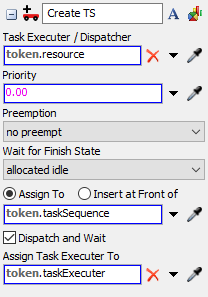Create Task Sequence
Overview and Key Concepts
The Create Task Sequence activity will create an empty task sequence and optionally dispatch it to a task executer.

A task sequence is a series of actions (known as tasks, such as Travel, Load, or Unload) that can be assigned to a task executer (such as an Operator or Transporter). Each task executer has a list of task sequences that have been dispatched to them. When a task executer finishes a task sequence, they will immediately begin executing the next task sequence in their list.
By default, this activity is configured to create a task sequence that uses a wait state. This means that once the Task Executer begins executing the task sequence, they will not move on to other task sequences until they are explicitly given a finish task. For this reason, this activity is meant to be paired with the Finish Task Sequence activity, which is used to give the finish task.
Connectors
The Create Task Sequence activity only allows one connector out. See Adding and Connecting Activities for more information.
Properties
The following image shows properties for the Create Task Sequence activity:

Each of these properties will be explained in the following sections.
Name
Used to change the name of the activity. See Name for more information about this property.
Font
The Font button
 opens a window to edit the activity's
background color and font properties. See
Font for more information
about this property.
opens a window to edit the activity's
background color and font properties. See
Font for more information
about this property.
Statistics
The Statistics button
 opens the activity's statistics
window. See Statistics
for more information about this property.
opens the activity's statistics
window. See Statistics
for more information about this property.
Task Executer / Dispatcher
Use the Task Executer / Dispatcher box to select the task
executer or dispatcher that you want to assign the task sequence to. If you want to create a
task sequence but not dispatch it, click the
 button so that this box now reads
None. If you want to dispatch the task sequence at a later time, you should click
the remove button and use Dispatch TS (Task Sequence) activity
to assign the task sequence to a task executer later in your process flow. See
Dispatch Task Sequence for
more information about this activity.
button so that this box now reads
None. If you want to dispatch the task sequence at a later time, you should click
the remove button and use Dispatch TS (Task Sequence) activity
to assign the task sequence to a task executer later in your process flow. See
Dispatch Task Sequence for
more information about this activity.
Priority
The Priority box sets the priority level of the task sequence. By default, task executers will complete task sequences and activities in the order they were received (first in, first out). However, you might want a task executer to complete more important tasks first. You can use the Priority box to cause the task executer to work on higher priority tasks sequences before lower priority task sequences.
By default, all task sequences are assigned a priority of 0, but you can enter in any number in the Priority box. By default, Task executers will prioritize task sequences to perform higher priority task sequences first through their Queue Strategy property. For example, imagine you create a task sequence with a priority number of 1 and another with a priority number of 2. If both task sequences are waiting in a task executer's queue to be performed next, the task executer will work on the task sequence with the priority number 2 first.
Preemption
The Preemption menu sets the preemption value of the task sequence. Preemption is when a task executer stops its current task sequence to work on the preempting task sequence. You can use the Preemption menu to determine if and how preemption occurs.
For example, Operator A's most important responsibility is to repair machines. When there are no machines to repair, however, it should also transport material throughout the model. If a machine breaks down while Operator A is in the middle of transporting a flow item somewhere, then the Operator should stop whatever it is doing and repair the machine, instead of finishing the transport operation. To simulate this behavior in your model, you'll have to make sure that the Operator's machine repair task sequence is set to preempt the task sequence for transporting flow items.
The Preemption menu has the following options:
- no preempt - The current task sequence will not preempt any other task sequences.
- preempt - The current task sequence will preempt any active task sequences. The active task sequence (the one that is being preempted) will go back into the task executer's queue to be finished later.
- preempt, aborting active - The current task sequence will preempt any active task sequences. The active task sequence (the one that is being preempted) will be deleted and will not be finished later.
- preempt, aborting all - The current task sequence will preempt any active task sequences. The active task sequence and all other task sequences in the task executer's queue will be deleted and will not be finished later.
Assign To
Assigns a reference on the specified label/node to the created task sequence. See the Assign To section of Common Properties for more information.
Dispatch and Wait
When this box is checked, the token will wait on this activity until a task executer begins executing this task sequence.
Assign Task Executer To
This field is only available if you check the Dispatch and Wait box. When the task executer begins executing the task sequence, this field will assign the task executer to a label. For example, if you dispatch the task sequence to a Dispatcher, then the task will eventually be given to a task executer. That task executer will be assigned to the label specified in this field.